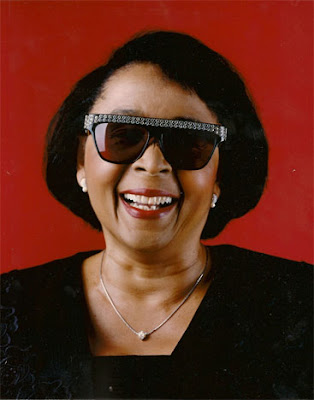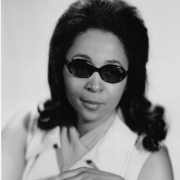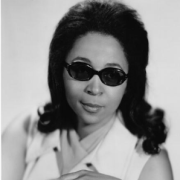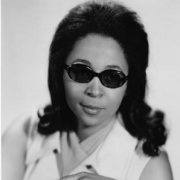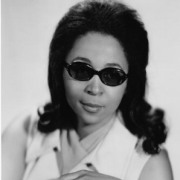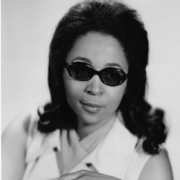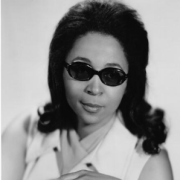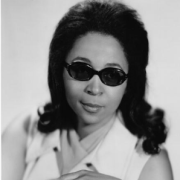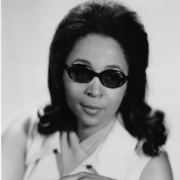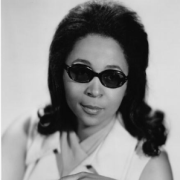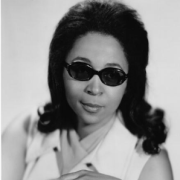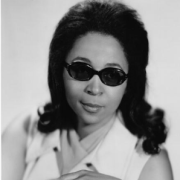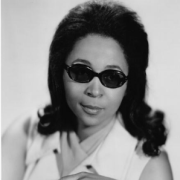AS OF JANUARY 13, 2023 FIVE HUNDRED MUSICAL ARTISTS HAVE BEEN FEATURED IN THE SOUND PROJECTIONS MAGAZINE THAT BEGAN ITS ONLINE PUBLICATION ON NOVEMBER 1, 2014.
ACCESS TO EACH ARTIST CAN BE FOUND IN THE 'BLOG ARCHIVE' (ARTISTS LISTED IN WEEKLY CHRONOLOGICAL ORDER) AND IN THE ‘LABELS’ SECTION (ARTIST NAMES, TOPICS, ETC.) ON THE RIGHT SIDE OF THE HOME PAGE. CLICK ON THESE RESPECTIVE LINKS TO ACCESS THEIR CONTENT:
https://soundprojections.blogspot.com/
https://soundprojections.blogspot.com/2022/11/valerie-capers-b-may-24-1935.html
PHOTO: VALERIE CAPERS (b. May 24, 1935)
Dr. Valerie Capers is a preeminent pianist, vocalist, educator, composer, and arranger. After graduating with bachelor’s and master’s degrees in classical composition and performance from The Juilliard School of Music, the first blind person to do so, Valerie undertook the next step in her musical career – learning to play jazz.
A naturally gifted musician, she has noted that dedication to the craft is necessary for success. In a Jazz Times interview with Sunsh Stein, she stated: “Developing your talent and skills is a very private and relentless thing. It doesn’t happen in a hurry. It’s very important to be organized, have discipline, and have an approach. Our ears are the most wonderful access to creativity and imagination because as musicians we hear everything, and those things get stored in some inner vault and come out in all sorts of ways we don’t expect.”
“Miss Capers’ cantata, with its
genuine jazz roots, is broadly in the vein of Duke Ellington’s Sacred
Concerts. But while Mr. Ellington worked out of his own personal style,
Miss Capers has found her sources in the entire spectrum of jazz and has
used them very perceptively as part of a continuity rather than the
miscellany of the Ellington Concerts.”
~John S. Wilson, The New York Times
“Left and right hands both played
important roles in her sound, and she proved expert at developing
tension and building dynamic statements in her solos. […] Spare, simple
lines, sometimes abbreviated in unexpected places, were followed by
involved, double-time statements. Quiet, singe-note phrases gave way to
rich harmonic passages that turned expertly back to their founding
theme.”
~Bill Kohlhaase, Los Angeles Times
“The work itself [Sing About Love]
is a joyous, wonderfully wrought celebration of the Christmas spirit as
seen through urban eyes. The presence of Miss Capers herself added to
this listener’s enjoyment.”
~Raoul Abdul, New York Amsterdam News
“Jazz lovers have long known
Valerie Capers as an outstanding pianist, singer, composer, and
educator. But her newest album, Wagner Takes the ‘A’ Train, is sure to
make her a favorite among opera lovers, too. The result is
intoxicating.”
~Brian Kellow, Opera News
“One of the highlights of the
evening was Capers’ recognition of the civil rights movement and its
impact on John Coltrane. By way of introduction, Capers, who is blind,
read (in Braille) of the 1963 bombing of a Baptist church in Alabama
that resulted in the deaths of four young girls. Coltrane was inspired
by the incident to write his profoundly moving “Alabama,” and the Capers
ensemble did it justice, beginning with a solemn and powerful opening
statement by Givens on tenor, followed by a mournful bowed bass solo,
Capers’ gospel-flavored piano and a guitar solo that segued back to
Givens on tenor. It was a stunning performance.”
~Tom Ineck, Berman Music Foundation – Jazz
“Surrounded by excellent musicians
(John Robinson, Earl Williams, Alan Givens, Mark Marino), she produced a
musical style of great elegance.”
~Dimanche Ouest-France, Nantes, France
https://www.allmusic.com/artist/valerie-capers-mn0000306859#biography
Valerie Capers
(b. May 24, 1935)
Biography by Scott Yanow
Although her 1995 Columbia recording Come on Home was released in a Legendary Pioneers of Jazz series, Valerie Capers is much too obscure and under-recorded to be a legend, and not old enough to be a pioneer. She picked out songs on the piano as a child before losing her sight at the age of six. Her blindness did not stop her from learning to read music in Braille and becoming the first blind graduate from the Juilliard School of Music. Although a classical player at the time, she was attracted to jazz, and was soon working with Mongo Santamaria. In 1965, Capers recorded for Atlantic; 17 years later, she would finally cut her second date (a self-produced effort for the tiny KM Arts label), and it would be another 13 years before her Columbia set. Capers did work with Ray Brown, Slide Hampton, James Moody, Max Roach, and Dizzy Gillespie in the interim, but was mostly employed as a high-level educator. Wagner Takes the "A" Train on Elysium appeared in 1999.
Valerie Capers
Bio

Dr. Valerie Capers was born in the Bronx and received her early schooling at the New York Institute for the Education of the Blind. She earned her bachelor’s and master’s degrees from The Juilliard School of Music, the first blind person to do so. For several years she served on the faculty of the Manhattan School of Music. She was also a member of the faculty in the Department of Music and Art at Bronx Community College of the City University of New York (CUNY) where she introduced several jazz courses to the music curriculum. From 1987 to 1995 she served as department chair, where she is now professor emerita.
Her outstanding work as an educator has been lauded throughout the country as being both innovative and impressive. Susquehanna University (Selinsgrove, Pennsylvania) awarded her the honorary degree of Doctor of Fine Arts, and Lehman College of the City University of New York, Doane University (Crete, Nebraska), and Bloomfield (New Jersey) College have also awarded her honorary doctorates. Teaching and workshop venues include Doane University; Stanford University; the Cleveland (Ohio) public school system; St. Thomas (United States Virgin Islands) high schools; Brigham Young University (Provo, Utah); the Mozarteum, University of Salzburg (Austria); Lenoir-Rhyne University (Hickory, North Carolina); Wellesley College (Wellesley, Massachusetts); University of Michigan (Ann Arbor); and Salt Lake City (Utah) Community College.
Among the awards and commissions she has received are the National Endowment for the Arts, including a special-projects grant to present a jazz series at the Bronx Museum of the Arts, Meet the Composer, the CUNY Research Foundation, the Smithsonian, and The Fund for Artists of Arts International. Dr. Capers was the first recipient of Essence magazine’s “Women of Essence Award for Music” where she was in the elite company of fellow honorees Oprah Winfrey and Marla Gibbs. She has been recognized by the Bronx Music Heritage Center as a Bronx Living Legend for her “enduring legacy to the American jazz tradition,” and she is a distinguished member of the Bronx Walk of Fame. In fall 2015, New York City Mayor Bill DeBlasio appointed her to the city’s prestigious Cultural Affairs Advisory Commission.
An accomplished composer, her most noted extended works are Sing About Love, the critically acclaimed Christmas cantata produced by George Wein at Carnegie Hall; Sojourner, an operatorio based on the life of Sojourner Truth, performed and staged by the Opera Ebony Company of New York and commissioned by the National Endowment for the Arts (NEA); and Song of the Seasons, a song cycle for voice, piano, and cello which was commissioned by the Smithsonian Institute and premiered in Washington, D.C., at the invitation of the Smithsonian, and since then, has been recorded by several artists.
Dr. Capers has appeared with her trio and ensemble at colleges, universities, jazz festivals, clubs, and concert halls throughout the country as well as internationally, including the Chautauqua Institution and Dizzy’s Coca-Cola Club (Jazz at Lincoln Center). She has also participated in the Monterey Jazz Festival; the DuPont Clifford Brown Jazz Festival (Wilmington, Delaware); Jazz in June (the University of Nebraska-Lincoln); Les Rendez-vous de l’Erdre (Nantes, France); the Mellon Jazz Festival (Philadelphia, Pennsylvania); Norfolk Chamber Music Festival, Yale Summer School of Music, Litchfield, Connecticut; New York City’s Kool, JVC and Downtown jazz festivals; the International Grande Parade du Jazz Festival (Nice, France); the Martin Luther King Festival (Ottawa, Ontario); the North Sea Jazz Festival (The Hague); and The Madeleine Festival of the Arts and Humanities: Valerie Capers and Friends (Salt Lake City, Utah). Dr. Capers is also regularly heard in New York City at The Kitano on Park Avenue South, and at the Knickerbocker Bar & Grill and Mezzrow, both in Greenwich Village.
Her numerous radio and television program appearances include Marian McPartland’s Piano Jazz (twice) and Branford Marsalis’ JazzSet. Adventures of Wagner in Jazz, a special program created by National Public Radio (NPR), and About Music (two separate programs, “Traditions and Personalities in Jazz Piano” and “American Composer and Piano Virtuoso: Louis Moreau Gottschalk”), were all broadcast on KBYU-FM in Provo, Utah, and carried throughout the country on NPR.
Throughout her career, she has performed with a roster of outstanding artists, including Dizzy Gillespie, Wynton Marsalis, Ray Brown, Mongo Santamaria, Tito Puente, Slide Hampton, Max Roach, James Moody, Paquito D’Rivera, and Jerry Weldon, among others.
Dr. Capers’ recordings include Portrait in Soul (Atlantic), Affirmation (KMA Arts), Come on Home (Columbia/Sony), Wagner Takes the ‘A’ Train (Elysium), and Limited Edition (VALCAP Music). Her book of intermediate-level piano pieces, Portraits in Jazz, was published by Oxford University Press (OUP) which has also published her arrangement of the English carol – “It Came upon the Midnight Clear” – for mixed chorus a cappella.
https://en.wikipedia.org/wiki/Valerie_Capers
Valerie Capers
External links
https://aaregistry.org/story/valerie-capers-musican-and-educator/
AFRICAN AMERICAN REGISTRY
AAREG
VALERIE CAPERS
Valerie Capers was born on May 24, 1935. in 1935. She is a blind Black musician and educator.
Valerie Capers was born in New York City and has been blind since the age of six, when an illness deprived her of her sight. She received her early schooling at the New York Institute for the Education of the Blind. She earned both her Bachelor's and Master's degrees from the Juilliard School of Music. From 1987 to 1995, she served on the faculty of the Manhattan School of Music, and was chair of the Department of Music and Art at Bronx Community College of the City University of New York (CUNY), where she is now professor emeritus. Three of Dr. Capers' most noted extended compositions are Sing About Love, Christmas cantata produced by George Wein at Carnegie Hall; Sojourner, an operatorio based on the life of Sojourner Truth, performed and staged by the Opera Ebony Company of New York; and Song of the Season.
Capers has appeared with her trio and ensemble at colleges, universities, jazz festivals, clubs and concert halls throughout the country, including a series at Weill Recital Hall and the 2001 Rendez-vous de l'Erdre in Nantes, France. Her trio's performances at the International Grande Parade du Jazz Festival in The Hague received rave reviews. The group has also participated in the Monterey Jazz Festival, the Mellon Jazz Festival, and New York's Kool, JVC and Downtown jazz festivals.
As a jazz artist, she is most often heard in New York City at the Knickerbocker in Greenwich Village. As a classical soloist, she has also performed Mozart's Concerto for Piano & Orchestra, No. 23 at the Pepperdine University Center for the Arts in Malibu, California. Capers’ recordings are: Portrait of Soul (Atlantic, 1967), Affirmation (KMA Arts, 1982), Come On Home (Columbia/Sony, 1995), Wagner Takes the A Train (Elysium, 1999), and her most recent, Limited Edition (VALCAP Records, 2001).
Oxford University Press published her book of intermediate-level piano pieces, Portraits in Jazz, in 2000. Dr. Capers' 2007 performances include: a concert at the Salzburg Global Seminar, Salzburg, Austria; the World-Wide Plaza Summer Festival New York City; the opening concert for the Women in Jazz Festival for Jazz at Lincoln Center at Dizzy's Coca-Cola Club New York City; the Gateway Music Festival Rochester New York; the Holiday Festival, the Empire State Building; and a Jazz at Noon Concert, the Empire State Building. She is also regularly heard in New York City at the Knickerbocker in Greenwich Village and the Lenox Lounge in Harlem. As a classical soloist, she has also performed Mozart's "Concerto for Piano & Orchestra, No. 23" at the Pepperdine University Center for the Arts in Malibu, California.
Dr. Capers has appeared on numerous radio and television programs with Marian McPartland, Branford Marsalis, Louis Moreau and others. She has also performed with Dizzy Gillespie, Wynton Marsalis, Ray Brown, Mongo Santamaria, Tito Puente, Slide Hampton, Max Roach, James Moody and Paquito D'Rivera, among others.
Valerie Capers was the first recipient of Essence magazine's "Women of Essence Award for Music." She remains very active in her life’s work.
cc
https://www.colorado.edu/project/hidden-voices/valerie-capers
HIDDEN VOICES: PIANO MUSIC BY BLACK WOMEN COMPOSERS
Valerie Capers
“Bossa Brazilia,” from Portraits in Jazz, by Valerie Capers
Valerie Capers
“Cool-Trane,” from Portraits in Jazz, by Valerie Capers
https://valcapmusic.com/publications/
Valerie Capers
Publications
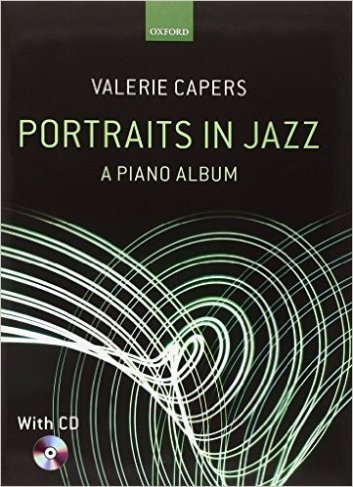
Portraits in Jazz: A Piano Album (Oxford University Press, 1992)
ISBN-10: 0193385627 / ISBN-13: 978-0193385627
Simple yet elegant piano pieces for intermediate standard players
(approximately grades 4-5) of any age with a demonstration CD.
by Valerie Capers
The Village Voice (circa 1985)
When speaking of the tenor saxophone, sooner or later it’s inevitable to speak of John Coltrane. This in itself is no small tribute to a man and his talent when we consider the extraordinary musicians who have found their home in the voice of the tenor—Lester Young, Ben Webster, and Coleman Hawkins, to mention only three. The impact of John Coltrane, however, extends far beyond the tenor saxophone itself.
Trane’s presence in the ’60s forever changed not only the concept of how to play the tenor, but how to play jazz as well. Yet there are those who write about jazz, with access to publishers and therefore the potential for enormous sales in academia, who either dismiss Trane with an offhand remark such as “he plays outside the beat,” or worse yet, omit him entirely from his historical niche in the ’60s. I recall being outraged when I heard a lecturer refer to John Coltrane as a “folk hero.” This statement is absolutely absurd. Paul Bunyan is a folk hero, not John Coltrane!
What was it about Trane that flamed the imagination of his contemporaries and sent them all scurrying to their private chambers for some critical self-analysis and heavy woodshedding?
First of all, we hear in Trane’s music a personal vision profoundly related to its time. Coltrane was and is a voice of the ‘60s.
Although he came up through the ranks of bebop, John emerged with something new at a time when the bebop period of Bird and Diz and Bud was a thing of the past—an immediate past, but the past nevertheless.
What, then, was the essence of Trane’s music? I have thought long and hard on the answer to this question and, with a reasonable degree of humility, I offer my thoughts and reflections for your consideration.
John’s music is not about melody, rhythm, and harmony alone. It extends far beyond that and becomes something spiritual, philosophical, and intellectual. There is a mystique about John Coltrane’s music and perhaps I can shed some light on it by expressing what this giant meant to me (a classical pianist at Juilliard, struggling from the arms of the European masters to embrace a new set of masters in a new musical idiom and discipline). The amazing thing about Coltrane is that you do not have to play the saxophone in order to feel the full weight of his influence.
The immediate thing that drew me to Trane was the magnetic force of his sound. John played with an energy and vitality that was totally compelling and his musical statements were powerful and expressive. Young aspiring horn players just discovering Trane often mistake his technique and full dynamics as the essence of his playing. This couldn’t be further from the truth because technique and tone were merely the tools of his artistic expression, not the end result. Trane’s music was about life as he perceived it, lived it, and reflected on it. He brought “verismo” (realism) to jazz in the ’60s and caused all of us to dig deep into ourselves and examine who we are as artists and how we relate to our fellow man.
As a devotee of Richard Wagner, I find a striking set of aesthetic parallels between his music and that of John Coltrane. We need not delve into the lives and innermost thoughts of a Mozart, Lester Young, or Sonny Stitt in order to appreciate and understand the works of these great musicians. However, with Wagner or Trane, you cannot separate the man from his art. Coltrane, like Wagner, exalts the artist to the highest calling in society, possessing the most powerful and positive forces for good and love in the world.
John Coltrane created a new dimension for the jazz musician. He became a voice of conscience—speaking out against conflict (Vietnam), poverty, and social injustice. As Trane saw it, such issues should indeed be the concerns of the artist. Think back and remember the cries of pain and frustrating emanating from his horn. Remember “Alabama”—a statement about four little girls who lost their lives in church one Sunday morning.
In talking with fellow musicians about Trane, one word in particular was always mentioned in describing his music—spiritual. As I see it, spirituality is at the core of Trane’s music and of his very existence. In understanding his philosophy, we gain an important insight into John’s musical concept.
Take, for example, the concept of time. In Wagnerian dramas, time is totally unrelated to the actual physical structure of time as we know it (60 minutes to the hour, 24 hours to the day, etc.). In Tristan and Isolde, for instance, a fleeting glance may be dramatically extended orchestrally in musical time-space. Likewise with Trane, the rhythm section playing an ostinato (repeated vamp pattern) establishes a steady rhythmic flow over which John moves melodically and rhythmically at will, unencumbered by the relentless beat or flow of time under his solo. Time, of course, is relative. If you have an hour to catch a plane and find yourself in a traffic jam on the way to the airport, an hour races by. That same hour, spent leisurely on the beach on a lazy summer day, moves at a much slower pace.
Stretching this concept of spirituality a step further, we are better able to comprehend Trane’s approach to melody and harmony. For example, a C major chord has certain fundamentals that determine how it is used and what is played with it. To Coltrane, however, a C major chord is no longer simply a C major chord. He transforms it into a texture of sound made up of a combination of tones having both an immediate and a more remote relationship to all other pitches and tones. This means that there is no such thing as playing “outside” or away from a tonal center because theoretically (or philosophically, if you like) there is no fixed tonal center. Such concepts were an integral part of John’s music.
For instance, in listening to “Green Dolphin Street” as played by Cannonball Adderley and Trane in Miles Davis’ old group, I hear a startling musical difference between those two giants. Cannonball played with a joy and swing that was fluid and spontaneous in spirit. Trane, on the other hand, played with a sense of forethought and consideration in what he expressed. His musical vocabulary was so impressive we were compelled to listen, whether we comprehended or not.
Another important thing for me about Trane’s playing was the growth and development in his music and his performances. I can think of no other musician in jazz whose musical concept is so clearly heard and documented from its early stages to its full-blown maturity. The evolution of this genius is dramatically discernable as we listen and follow the Coltrane discography year after year.
This was a particular inspiration for young musicians such as myself, struggling to create our own concepts. Trane’s constant striving for the next plateau was an indescribable joy.
Despite the nearly 20 years since the physical passing of John Coltrane, there remains an intensity of feeling and emotion about this man and his music. Even today musicians continue to look to Trane as a source of inspiration, enlightenment, and new challenges. His music is studied and performed all over the world, and Coltrane is recognized as one of the most significant musicians of the 20th century in American music. What a triumph for a man who was so harshly criticized and so totally misunderstood back in the early ’60s. Time and time again history has shown us that intellect, genius, and creativity cannot be bound or imprisoned by walls of established tradition, social rejection, or lack of financial success. If this were not so, the humanities would be diminished by the loss of such visionaries as Beethoven, Stravinsky, Monk, and, of course, John Coltrane.
My thoughts as expressed here are not concerned with deciding who is the better player—Trane or Rollins or Webster; that would be as silly as discussing which is the better ocean, the Atlantic or the Pacific. I would rather enjoy the unique genius of each individual artist on its own terms. I would no more wish to live in a world without Gene Ammons and Lester Young than I would John Coltrane.
In John’s composition “A Love Supreme”, he acknowledges the Creator as the spirit within all of us—thus connecting each of us to the other and all of us with the infinity of the universe.
Thank you, John!
https://africandiasporamusicproject.org/valerie_capers
https://valcapmusic.com/compositions-recordings/
Compositions & Recordings
Extended Works
The Ring Thing (1993)
Song of the Seasons (1987)
The Gift of Song (1986)
Escenas Afro-Cubanas (1985)
Duke Ellington Choral Medley (1984)
Psalm 150 (1980)
Sojourner (1980)
In Praise of Freedom (1976)
Sing About Love (1974)
Songs
Ah Ha
Always You
The Birthday Song
Blue Monday
Bronx Song
Brotherhood Begins with You and Me (from In Praise of Freedom)
Chili Beans
Christmas Is Love
El Toro
He’s There
Hey Stuff!
Kenne’s Soul
La Gitana
Little David Swing
Odyssey
Oh So Wonderful (from Psalm 150)
Organum
Out of All (He’s Chosen Me) (from Sing About Love)
Sabrosa
Sarai
Stepping Stones
Together
Wagner Takes the ‘A’ Train (Richard Wagner/Billy Strayhorn, arr. Capers)
Waltz Pierrot
West Fourth Street
Wild Cattin’
Winter’s Love (based on two themes from Wagner’s opera Die Walküre)
Recordings
Limited Edition (Valcap Music, 2001)
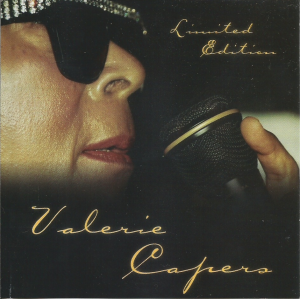
Capers, piano/vocals – John Robinson, bass – Earl Williams, drums – Al Harewood, drums – Alan Givens, tenor and soprano saxophones, flute – Mark Marino, guitar
Produced by Valerie Capers and Andrew Rowan
Arrival (Horace Parlan)
Sister Sadie (Horace Silver)
I’ve Never Been in Love Before (Frank Loesser)
It’s All Right with Me (Cole Porter)
Lush Life (Billy Strayhorn)
Nature Boy (Eden Ahbez)
Organum (Capers)
Rhythm-a-ning (Thelonious Monk)
Blue Monk (Monk)
Blood Count (Strayhorn)
Perdido (Juan Tizol/Ervin M. Drake/Hans Lengsfelder)
https://valcapmusic.com/honors-awards/
Honors & Awards
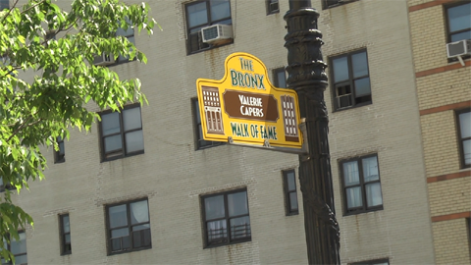
- Valerie Capers is inducted into The Bronx Walk of Fame
APPOINTMENTS
- New York City Cultural Affairs Advisory Commission, Member
AWARDS
- Bronx Living Legend, Bronx Music Heritage Center
- Bronx Walk of Fame
- Valerie Capers Day, Borough of the Bronx, April 2, 1995
- Women of Essence Award for Music, Essence Magazine
GRANTS
- CUNY Research Foundation
- The Fund for Artists of Arts International
- Meet the Composer
- National Endowment for the Arts, Jazz Series, Bronx Museum of the Arts
- Smithsonian Institution, Washington, D.C.
HONORARY DOCTORATES
- Bloomfield College, Bloomfield, New Jersey
- Doane University, Crete, Nebraska
- Lehman College of the City University of New York, Bronx, New York
- Susquehanna University, Selinsgrove, Pennsylvania
https://research.library.fordham.edu/baahp_oralhist/163/
Disciplines
African American Studies
Abstract
Interviewee: Valerie Capers
Interviewer: Dr. Mark Naison, Maxine Gordon, Dawn Russell
Date of Interview: December 14, 2006
Summarized by Alice Stryker
Valerie’s parents grew up in Harlem. Her maternal great grandmother came to Harlem from Virginia. After the couple was married they moved to the Bronx. She thinks that many newlyweds at the time would move from Harlem to the Bronx. When she was born, the family was living on 168th street between Union and Prospect Avenue. While she was living there, she lost her sight. When she was young she lost her vision. She had pink eye that would not go away and described one of the last scenes she saw. After 8 months in the children’s ward of a hospital, she finally was released. Soon after, the family moved to Union Avenue between Ritter and Freeman. In 1967, the family moved to Anthony Avenue, which is up near Grand Concourse. She mentions her Indian ancestry, which she gets from her mothers side. Her father was one of the first African American supervisors for the Postal Service.
When she was growing up she was surrounded by music. Her father was a jazz player and had many friends who played jazz as well. She also was sent to dance school. The family also had a lot of records. When she was 7 or 8 she started fooling around on the piano, not formerly learning how to play that is.
The family attended church at St. Augustine Church. The minister was Reverend Hawkins. She called Reverend Hawkins her blood father because he gave her his blood when she was very sick.
When she was attending the Institute for the Blind she formed real friendships. She attended high school there as well and graduated in 1953 and was the valedictorian of her class. The school was live-in and there was no emphasis on her being colored. There were many talented performers at the school and the school was invited to perform in Washington, a segregated city. She however, did not go because she did not want to be housed separately from her friends. When she was at the Institute she had very attentive and formal training on the piano using brail music books. After graduating, she took an additional year at the institute to prepare her for the Julliard auditions. She was talented enough and attended Julliard.
After Julliard, she began teaching. It was during this time that she moved away from concert piano to jazz. She got many of her students through the churches she was affiliated with. She eventually started teaching at a school. The first gigs she started playing as a jazz musician were with her brother, who was a very talented horn player. At that time, she wasn’t very good. In 1967 she got on the faculty of the Manhattan School of Music. At the time she began taking classes to get certified to teach in New York City Public Schools. In 1971, she began teaching at Bronx Community College.
She began composing when she was at Julliard. She had always been creating little melodies or tunes, but at Julliard she had a composition assignment which made her become more serious about her compositions. Her brother Bobby was a major inspiration for her to begin composing full time. He was unable to notate a rhythm and she was able to help him do it. The piece was called “El Torro” and it helped Bobby land a very important gig. She then talks about the other pieces that helped to make her brother famous. She also talks about the other musicians she knew that were from the Bronx.
Recommended Citation
Capers, Valerie. Interview 1. December 14, 2006. Interview with the Bronx African American History Project. BAAHP Digital Archive at Fordham.
Valerie Capers Ensemble
National Jazz Museum in Harlem
Streamed live on March 31, 2022:
Valerie Capers - piano
John Robinson - bass
Alan Givens - saxophone and flute
Doug Richardson - drums
Interview with composer Valerie Capers
